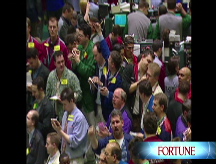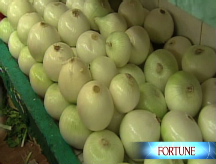OPEC's empty toolkit
The leaders of OPEC says its members have plenty of oil to meet demand. So why aren't they putting more on the market?

NEW YORK (Fortune) -- The leaders of OPEC have a long list of culprits for high oil prices: the falling dollar, U.S.-Iranian tensions, and shady speculators.
Here's one they seem to forget: OPEC.
The Organization of Petroleum Exporting Countries consistently claims that supply is not a problem - that there's plenty of oil to meet demand.
But last year, as the price of oil nearly doubled, OPEC was actually cutting production. The cartel produced 1.5% less last year despite adding two countries, Angola and Ecuador, to its ranks. That cutback at a time of growing demand helped drive prices up.
"They made a mistake," says Adam Sieminski, chief energy economist for Deutsche Bank, who thinks OPEC's drop in production last year is the No. 1 reason for today's prices. "The Saudis are responsible for trying to manage the world market. They underestimated demand and they overestimated non-OPEC supply."
To get the full context for OPEC's cut, we need to go back to the fall of 2006, when the world was a very different place. The price of oil was falling fast, from a high of $78 in August to below $60 by late October. Hedge funds were reportedly piling into the market and driving the price lower. The poo-bahs of OPEC probably had flashbacks to the mid-1980s oil-price collapse. The cartel decided it was time to act.
On Oct. 20, OPEC voted to drop production by 1.2 million barrels per day.
That day may have been the last time OPEC had control of the oil market. By mid-January, oil bottomed at $51 per barrel and then began its extraordinary rise. Now we're flirting with $150.
The question is: Can OPEC now undo what it has helped to create?
Last week OPEC released its World Oil Outlook 2008, a 214-page report that can be summed up in one reassuring sentence from the foreword by OPEC Secretary-General Abdalla Salem El-Badri: "Availability is not an issue." Despite increasing demand, the report promises plentiful oil for decades to come.
Not surprisingly, then, El-Badri, who also runs Libya's national oil company, argues that, at $140, the price of crude oil is out of whack with reality.
"Today, what is apparent is that oil supply and demand fundamentals are healthy," he writes. "There is, and has been, more than enough supply to meet demand, and oil stocks in major consuming countries are at comfortable levels. This should point away from the direction of current price levels."
In recent weeks, while Congress has been holding dozens of hearings to try to figure out who to blame for the rude price of crude, the Secretary-General and his colleague Chakib Khelil, the president of OPEC and head of Algeria's oil ministry, have offered a variety of explanations. Khelil has cited the falling value of the U.S. dollar, referenced tensions between the U.S. and Iran, and pointed the finger at hedge fund speculators. (It's hard to argue with the first two, but I generally side with my colleague Jon Birger in believing that it's bogus to blame speculators.) Saudi Arabia called an emergency oil summit last month, the main purpose of which seemed to be to get out the message that rising prices weren't the cartel's fault.
But it's disingenuous for OPEC's leadership to suggest that reduced production had nothing to do with rising prices. OPEC pumps 44% of the world's daily oil production and, by its own count, has 78% of the world's proven reserves. In an increasingly tight market, there's no room for the largest group of producers to drop its output without directly affecting prices. And indeed, in announcements before and during the summit, the Saudis pledged to boost production by some 500,000 barrels a day.
The scary thought - held by observers like peak oil guru Matt Simmons and commodities investor Jim Rogers - is that the cartel can't do much more than that because the easy oil is already out of the ground.
"They've been telling us for years that they have between two and three million barrels of [daily] spare capacity," says Gal Luft, the executive director of the Institute for the Analysis of Global Security. "If you have it and you don't use it then you are deliberately denying liquidity to the market when it needs it. If they have it, why don't they use it? And if they don't have it, we need to know that. We need to put more oil in our strategic reserve."
OPEC has apparently given its members the green light to pump all they want, according to a survey released by energy news service Platts last month. The Platts press release about the survey says that "OPEC has a 'tacit' understanding that those members capable of boosting crude production should supply as much oil as world oil markets needed."
In other words, the leaders of OPEC are trying to regain control of oil prices and offer relief to their agitated customers, although Platts Global Director of Oil John Kingston sounded skeptical about how successful OPEC could be. "It's clear that with non-OPEC output continuing to sag, and world demand staying flat regardless of high prices, that any additional supply most likely must come from OPEC," he is quoted as saying. "But...its ability to put much more oil on the market looks severely constrained."
Over the weekend, another important OPEC figure offered his thoughts on the price of oil. Venezuela's Hugo Chavez said on Sunday that crude is in a speculative bubble and that it might hit $200 per barrel. (He also took the opportunity to threaten to cut off supplies to the U.S. and drive the price up to $300 if Exxon didn't back off in a dispute over its assets in his country.)
At $200, Deutsche Bank's Sieminski calculates, global GDP growth would fall to a mere 2%. "That would stop demand growth," he says.
Rather than find out if he's right, let's hope OPEC's efforts to drive prices down today are half as effective as its efforts to raise them were in 2006. ![]()
-
 The retail giant tops the Fortune 500 for the second year in a row. Who else made the list? More
The retail giant tops the Fortune 500 for the second year in a row. Who else made the list? More -
 This group of companies is all about social networking to connect with their customers. More
This group of companies is all about social networking to connect with their customers. More -
 The fight over the cholesterol medication is keeping a generic version from hitting the market. More
The fight over the cholesterol medication is keeping a generic version from hitting the market. More -
 Bin Laden may be dead, but the terrorist group he led doesn't need his money. More
Bin Laden may be dead, but the terrorist group he led doesn't need his money. More -
 U.S. real estate might be a mess, but in other parts of the world, home prices are jumping. More
U.S. real estate might be a mess, but in other parts of the world, home prices are jumping. More -
 Libya's output is a fraction of global production, but it's crucial to the nation's economy. More
Libya's output is a fraction of global production, but it's crucial to the nation's economy. More -
 Once rates start to rise, things could get ugly fast for our neighbors to the north. More
Once rates start to rise, things could get ugly fast for our neighbors to the north. More










